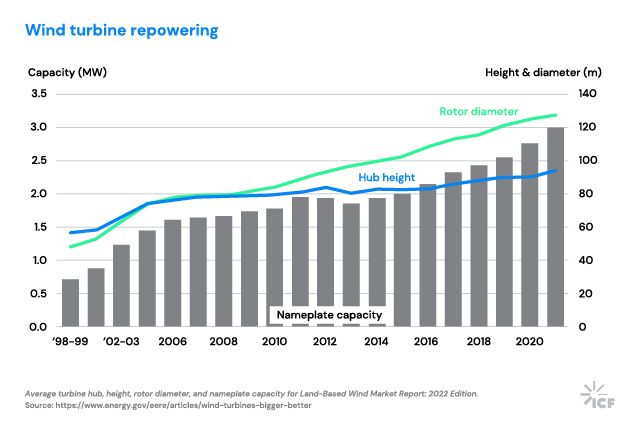
For investors, wind turbine repowering offers efficiency and lifespan benefits
According to the U.S. Energy Information Administration - EIA - Independent Statistics and Analysis, a typical turbine installed in 2006 had an average nameplate capacity of 1.6 MW, and a typical turbine installed in 2021 had an average nameplate capacity of 3.0 MW. This is an increase of almost 88% in power output. In the same period, the average rotor diameter increased from 80m to 127m. This represents a growth of more than 58%. These numbers illustrate how effective repowering can be for each turbine.

Wind turbine repowering is the process of upgrading or replacing components of an existing wind turbine to improve its performance and efficiency. The scope of wind turbine repowering can vary from project to project, but the goal is to improve the performance of the wind turbine and maximize its energy production. This can involve replacing wind turbines with newer and larger variants of one or all components such as the blades, nacelle, and the control systems and electronics. The entire wind turbine may be replaced for some projects. Repowering can help to extend the useful life of a wind turbine and increase its energy output, making it more cost-effective. Repowering wind turbines ensures they can produce electricity at a low cost.
The cost of wind turbine repowering depends on factors such as the size of the turbines, the type of components being replaced, the location of the project, and labor and material costs. As with any major capital project, investors should carefully evaluate the cost of wind turbine repowering and weigh it against the expected benefits of increased energy production and cost savings over the life of the wind turbine.
Upgrading existing wind turbines with new technology can increase efficiency, allowing them to produce more energy from the same amount of wind. Repowering can increase the efficiency of wind turbines in several ways:
- Larger rotor diameter: A larger rotor diameter can capture more energy from the wind. The increase in rotor diameter also allows the turbine to generate more power at lower wind speeds.
- Improved technology: Advancements in turbine technology have led to more efficient designs, such as better blade shapes and materials, improved gearboxes, and more efficient generators. These improvements allow the turbine to convert more of the wind energy into electricity.
- Higher hub heights: Older wind turbines were typically built with lower hub heights, which limited the amount of wind energy that could be captured. Newer turbines often have higher hub heights, which allows them to capture stronger and more consistent winds.
- Improved control systems: Newer turbines have more sophisticated control systems that can optimize the turbine's performance based on the wind conditions. For example, the turbine may be able to adjust the blade pitch angle or rotor speed to optimize power production based on the wind speed and direction. These control systems can help increase efficiency and reduce maintenance costs.
Incorporating new turbine equipment extends the lifespan of a wind turbine. New turbine equipment does not have any wear. Repowering can help to extend the lifespan of wind turbines, which are typically designed to last for 20-25 years. Repowering can extend the lifespan of a wind turbine in several ways:
- Improved reliability: Older turbines may have components that are more prone to failure due to wear and tear. Repowering involves replacing these components with newer, more reliable ones, which can reduce the risk of downtime.
- Increased capacity: Repowering often involves replacing older turbines with newer, more powerful ones.
- Upgraded technology: Repowering often involves upgrading the technology used in the turbine, such as the control systems or blade materials. These upgrades can improve the turbine's performance and efficiency, which can reduce the stress on the turbine.
- Improved maintenance: Repowering often involves upgrading the maintenance and monitoring systems for the turbine. This can allow for more proactive maintenance, which can catch potential issues before they become serious.
Repowering wind turbines requires checking of components that will not be replaced. It is important for owners of the wind farm to evaluate the following components if they are to stay in service with the repowered turbine.
- Foundation: Evaluate the foundation for remaining useful life, including fatigue analysis, serviceability, and strength.
- Electrical components: Evaluate the electrical components for serviceability, wear, and electrical load.
- Tower: Evaluate the tower for remaining useful life, including fatigue analysis and serviceability.
- Replacement components: Lastly, if you are repowering a turbine, the replacement components may be supplied by a different manufacturer than the originals. It is critical to have a control scheme that operates the wind turbine system within the design parameters of all the components.
Repowering can improve maintenance and can extend operational life. Newer equipment includes newer technology and less maintenance due to less wear. By improving the efficiency of wind turbines, repowering can help to reduce operating costs and increase the overall cost-effectiveness of wind energy.